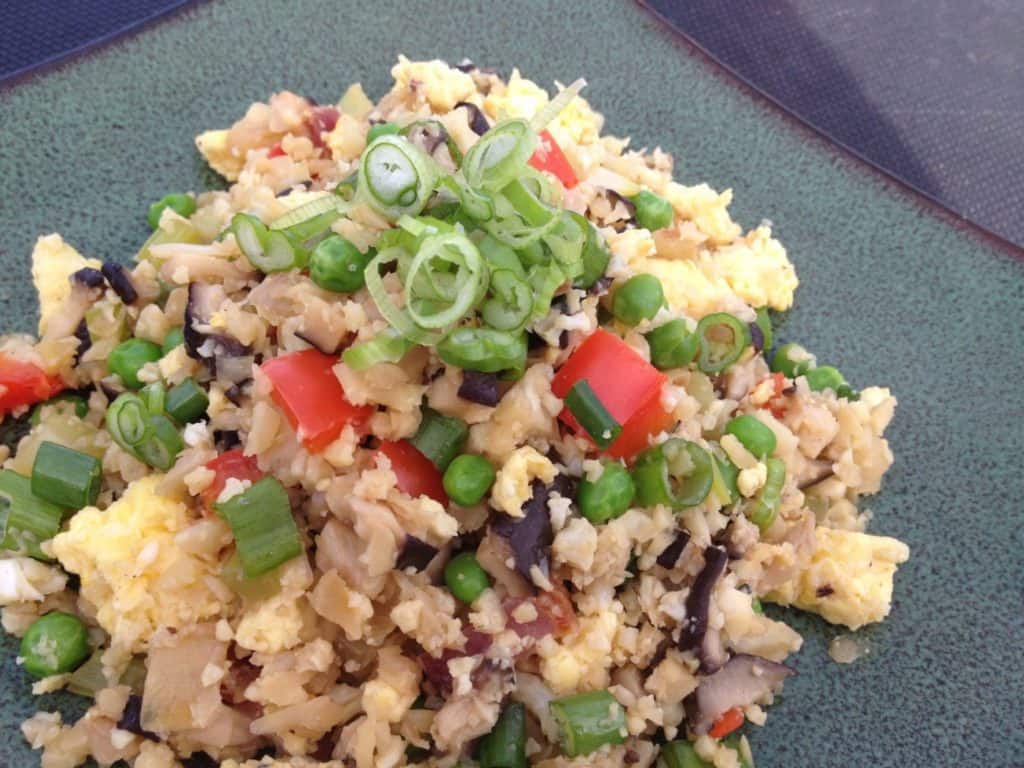Okay, so this recipe doesn’t really include rice at all. Sorry to disappoint all you rice-loving folks. Hey, I love me some rice, too; don’t get me wrong. One of my favorite ways to enjoy this universal staple is by treating it as the base for a substantial, nutritionally balanced, one-pot meal full of other yummy goodies: aka fried rice. The main problem with this is I need to have some precooked rice on hand, preferably cold, as cold rice makes for the best finished product. This doesn’t factor well when I get a craving for fried rice and want it NOW! Not to mention that I’m always looking for ways to increase my vegetable intake and decrease my glycemic load. Enter the humble and versatile cauliflower.
Now, I’m not going to lie: If you’re looking for a “fooled you” substitute for rice that tastes exactly like rice and soaks up juicy liquids the way rice does, then cauliflower just isn’t going to cut it for you. In that case, I say you just use leftover rice or another steamed whole grain for this recipe. However, if you are willing and have an open mind, and overlook the fact that most substitutions for anything are never going to be exactly the same as the real thing (especially something that is not a grain being swapped for something that is), then I know you will love this recipe!
Besides being super delicious and satisfying, one of the best things about cauliflower fried “rice” is that it is practically a blank canvas waiting to be painted with whatever odds and ends you have on hand. The canvas is always open for any additions and substitutions. Got some leftover chicken? Dice it up and throw it in, likewise with any other meat or seafood, as well as any vegetable you need to use up. As is, this recipe includes enough protein from the eggs and bacon that I would consider it a complete meal; however, you might want to treat it like a side dish to a stir-fry or a juicy cut of roasted or grilled meat.
Ingredients
Serves 4 as a main course; 6–8 as a side dish
¼–½ pound bacon, chopped and cooked until crisp (I always make the larger amount because I invariably end up snacking while I cook)
4–6 eggs (preferably pastured eggs)
2 tablespoons water
1 teaspoon tamari
1 large head cauliflower, broken into florets (alternately, use 4 cups cooked, cooled rice or other grain)
1 onion, diced
3 stalks celery, diced
½ pound mushrooms (shitakes are particularly good here), diced
1 bell pepper, diced
1 cup fresh or frozen peas
1 bunch green onions, sliced
Sesame oil, for stir-frying
2–3 tablespoons tamari, or to taste
Instructions
1. Place cauliflower florets in the bowl of a food processor, working in batches if necessary. Pulse cauliflower until finely chopped, about the size of rice. Alternately use grater attachment for food processor or grate cauliflower by hand. Set aside in a large bowl.
2. Cook diced bacon until crisp. Drain on paper towels. Try not to eat too much while you cook the rest of the dish. Reserve bacon drippings to fry egg, if desired. If using the same pan to cook the veggies, wash well with soap and water before proceeding.
3. Beat eggs with water and 1 teaspoon tamari. Season with fresh pepper. Heat a clean pan or wok and some reserved bacon drippings or sesame oil over medium heat. Add egg and scramble until cooked through. Transfer to a small bowl, and set aside.
4. Wipe pan clean. Heat some additional sesame oil in pan, and cook onions until translucent, about 3 minutes. Add celery and mushrooms and a sprinkle of salt. Saute for 2–3 minutes. Add bell pepper, cauliflower, and peas. Saute for a few more minutes, until about halfway cooked through. Add tamari, and stir to combine. Keep cooking until all the vegetables are tender, about 3–5 minutes. Add green onions, egg, and bacon to pan. Toss to combine. Taste and adjust seasoning adding additional tamari, salt, and pepper to your liking. Serve piping hot.
AUTHOR’S NOTE
To choose your organically grown and fresh ingredients wisely, use the following criteria:
·chemical- and hormone-free meat
·wild-caught fish
·pastured-raised, organic eggs
·whole, unrefined grains
·virgin, unrefined, first-press organic oils
·whole-food, unrefined sweeteners
·pure, clean, spring water
·sea salt
·raw and/or cultured milk and cream products




